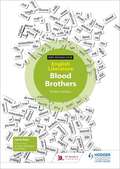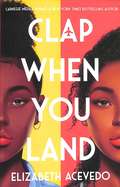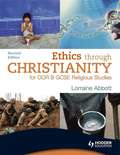- Table View
- List View
WJEC Eduqas GCSE English Literature Set Text Teacher Guide: Blood Brothers (PDF)
by Paula AdairConfidently teach Blood Brothers using classroom-ready, manageable schemes of work that ensure you cover the full text in 10-12 weeks. This Set Text Teacher Guide: - Enables you to navigate efficiently through Blood Brothers, improving your students' textual understanding and analytical skills week by week - Reduces your planning time by providing explanatory teaching notes and photocopiable student worksheets that are closely aligned to the Assessment Objectives - Caters for students of varying abilities with extra support for the less able and suitably challenging activities to stretch high achievers - Helps you map student progress across the course through a mix of short activities and more formal assessments - Includes a dedicated section on exam preparation with practice questions, student-friendly mark schemes and advice on writing high-level answers in timed conditions
WJEC GCSE English and English Language: Revision Workbook (PDF)
by Paula AdairThis workbook has been written for in-class revision sessions and is fully supported by the WJEC In-Class Revision Teacher Pack. A clear, full-colour page design makes it easy for every student to progress through the workbook. Skills to raise my grade features in every lesson help students track their own progress and identify areas to improve upon.nbsp;
Clap When You Land (PDF)
by Elizabeth AcevedoThe stunning New York Times bestselling novel from the 2019 Carnegie Medal winning, Waterstones Book Prize shortlisted author of THE POET X. 2020 Goodreads Choice Award Winner of CLAP WHEN YOU LAND. Camino Rios lives for the summers when her father visits her in the Dominican Republic. But this time, on the day when his plane is supposed to land, Camino arrives at the airport to see crowds of crying people... In New York City, Yahaira Rios is called to the principal's office, where her mother is waiting to tell her that her father, her hero, has died in a plane crash. Separated by distance - and Papi's secrets - the two girls are forced to face a new reality in which their father is dead and their lives are forever altered. And then, when it seems like they've lost everything of their father, they learn of each other. In a dual narrative novel in verse that brims with both grief and love, award-winning and bestselling author Elizabeth Acevedo writes about the devastation of loss, the difficulty of forgiveness, and the bittersweet bonds that shape our lives.
Edexcel International GCSE Arabic 1st Language Student Book (PDF)
by Eltayeb Ali Abusin Hazim AbbasProvides extensive support for the required grammar points. Includes guidance on different writing styles such as letter writing, speech, reports, articles, narrative and more. Provides assistance to students with reading comprehension through a variety of different reading passages. Provides academic and technical support for exam questions. Exam-focused exercises and activities throughout.
Ethics through Christianity for OCR B GCSE Religious Studies (PDF)
by Lorraine AbbottThis successful textbook for OCR Ethics has been re-editioned to support the 2009 OCR GCSE Religious Studies B specification. It can be used to deliver the short course for OCR GCSE RS B in ethics. It delivers the course through Christianity only, and therefore provides an in depth look at the issues in question. The book has a range of activities to engage the students; from key questions, discussion points, research tasks, extension activities to exam questions. Personal accounts of beliefs and experiences intersperse the main text to allow students to relate to the material they are reading. Each unit is summarised in the form of revision 'cards' to give students a 'snapshot look' at what they have just learned and need to learn for the exam. This book can be combined with Philosophy through Christianity for OCR B GCSE Religious Studies: Second Edition to provide support for the full course.
Climate Graph - Cool, temperate maritime: Shannon, Ireland (Large Print)
This is a graph showing temperature and precipitation over the period of a year in Shannon. There is a locator dot shown, which will be at the top left of the page when the image is the right way up. There are vertical bars indicating average monthly rainfall and a thick dashed line going across the page showing the average monthly temperature. On the left of the page is a vertical scale marked in degrees Centigrade starting from zero at the bottom. It is marked at every five degrees and labelled at every ten degrees. Running right across the page are fine horizontal grid lines. The thick dashed line representing the temperature can be found at the bottom left of the page sloping up and down to right. Across the bottom of the page are twelve labelled vertical bars showing the rainfall for each month of the year, starting with January on the left. To allow sufficient space, the braille labels are uncapitalised. At the far right of the page is a vertical scale of precipitation in millimetres, starting with zero at the bottom. This is marked every 25 mm and labelled every 50 mm.
Climate Graph - Cool, temperate maritime: Shannon, Ireland (UEB Contracted)
This is a graph showing temperature and precipitation over the period of a year in Shannon. There is a locator dot shown, which will be at the top left of the page when the image is the right way up. There are vertical bars indicating average monthly rainfall and a thick dashed line going across the page showing the average monthly temperature. On the left of the page is a vertical scale marked in degrees Centigrade starting from zero at the bottom. It is marked at every five degrees and labelled at every ten degrees. Running right across the page are fine horizontal grid lines. The thick dashed line representing the temperature can be found at the bottom left of the page sloping up and down to right. Across the bottom of the page are twelve labelled vertical bars showing the rainfall for each month of the year, starting with January on the left. To allow sufficient space, the braille labels are uncapitalised. At the far right of the page is a vertical scale of precipitation in millimetres, starting with zero at the bottom. This is marked every 25 mm and labelled every 50 mm.
Climate Graph - Cool, temperate maritime: Shannon, Ireland (UEB Uncontracted)
This is a graph showing temperature and precipitation over the period of a year in Shannon. There is a locator dot shown, which will be at the top left of the page when the image is the right way up. There are vertical bars indicating average monthly rainfall and a thick dashed line going across the page showing the average monthly temperature. On the left of the page is a vertical scale marked in degrees Centigrade starting from zero at the bottom. It is marked at every five degrees and labelled at every ten degrees. Running right across the page are fine horizontal grid lines. The thick dashed line representing the temperature can be found at the bottom left of the page sloping up and down to right. Across the bottom of the page are twelve labelled vertical bars showing the rainfall for each month of the year, starting with January on the left. To allow sufficient space, the braille labels are uncapitalised. At the far right of the page is a vertical scale of precipitation in millimetres, starting with zero at the bottom. This is marked every 25 mm and labelled every 50 mm.
Climate Graph- Mediterranean: Rome, Italy (Large Print)
This is a graph showing temperature and precipitation over the period of a year in Rome. There is a locator dot shown, which will be at the top left of the page when the image is the right way up. There are vertical bars indicating average monthly rainfall and a thick dashed line going across the page showing the average monthly temperature. On the left of the page is a vertical scale marked in degrees Centigrade starting from zero at the bottom. It is marked at every five degrees and labelled at every ten degrees. Running right across the page are fine horizontal grid lines. The thick dashed line representing the temperature can be found at the bottom left of the page sloping up and down to right. Across the bottom of the page are twelve labelled vertical bars showing the rainfall for each month of the year, starting with January on the left. To allow sufficient space, the braille labels are uncapitalised. At the far right of the page is a vertical scale of precipitation in millimetres, starting with zero at the bottom. This is marked every 25 mm and labelled every 50 mm.
Climate Graph- Mediterranean: Rome, Italy (UEB Contracted)
This is a graph showing temperature and precipitation over the period of a year in Rome. There is a locator dot shown, which will be at the top left of the page when the image is the right way up. There are vertical bars indicating average monthly rainfall and a thick dashed line going across the page showing the average monthly temperature. On the left of the page is a vertical scale marked in degrees Centigrade starting from zero at the bottom. It is marked at every five degrees and labelled at every ten degrees. Running right across the page are fine horizontal grid lines. The thick dashed line representing the temperature can be found at the bottom left of the page sloping up and down to right. Across the bottom of the page are twelve labelled vertical bars showing the rainfall for each month of the year, starting with January on the left. To allow sufficient space, the braille labels are uncapitalised. At the far right of the page is a vertical scale of precipitation in millimetres, starting with zero at the bottom. This is marked every 25 mm and labelled every 50 mm.
Climate Graph- Mediterranean: Rome, Italy (UEB Uncontracted)
This is a graph showing temperature and precipitation over the period of a year in Rome. There is a locator dot shown, which will be at the top left of the page when the image is the right way up. There are vertical bars indicating average monthly rainfall and a thick dashed line going across the page showing the average monthly temperature. On the left of the page is a vertical scale marked in degrees Centigrade starting from zero at the bottom. It is marked at every five degrees and labelled at every ten degrees. Running right across the page are fine horizontal grid lines. The thick dashed line representing the temperature can be found at the bottom left of the page sloping up and down to right. Across the bottom of the page are twelve labelled vertical bars showing the rainfall for each month of the year, starting with January on the left. To allow sufficient space, the braille labels are uncapitalised. At the far right of the page is a vertical scale of precipitation in millimetres, starting with zero at the bottom. This is marked every 25 mm and labelled every 50 mm.
Congruency
This diagram consists of two pairs of congruent shapes; two triangles in the middle of the page and two irregular shapes at the bottom of the page. A locator dot and title are shown. These must always be at the top left of the page when the image is the right way up. The top two are congruent - the one on the right is in a mirrored position. The diagram shows how their congruency is proved. The bottom two are also congruent - the one on the right is in a rotated position. When shapes are congruent they are the same size and shape but can be rotated and/or mirrored.
Congruency
This diagram consists of two pairs of congruent shapes; two triangles in the middle of the page and two irregular shapes at the bottom of the page. A locator dot and title are shown. These must always be at the top left of the page when the image is the right way up. The top two are congruent - the one on the right is in a mirrored position. The diagram shows how their congruency is proved. The bottom two are also congruent - the one on the right is in a rotated position. When shapes are congruent they are the same size and shape but can be rotated and/or mirrored.
Cross section of a ball and socket joint (Large Print)
The hip socket is in the top left of the page and the ball of the femur is in the centre of the page. The diagram is surrounded by an image border. A locator dot and title are shown. These must always be at the top left of the page when the image is the right way up. The upper end of the femur is in the bottom right of the page. It leads up to the femoral head which connects to the ball of the joint. The joint has a ligament holding the two bones together to the upper right and lower left of the page.
Cross section of a ball and socket joint (UEB Contracted)
The hip socket is in the top left of the page and the ball of the femur is in the centre of the page. The diagram is surrounded by an image border. A locator dot and title are shown. These must always be at the top left of the page when the image is the right way up. The upper end of the femur is in the bottom right of the page. It leads up to the femoral head which connects to the ball of the joint. The joint has a ligament holding the two bones together to the upper right and lower left of the page.
Cross section of a ball and socket joint (UEB Uncontracted)
The hip socket is in the top left of the page and the ball of the femur is in the centre of the page. The diagram is surrounded by an image border. A locator dot and title are shown. These must always be at the top left of the page when the image is the right way up. The upper end of the femur is in the bottom right of the page. It leads up to the femoral head which connects to the ball of the joint. The joint has a ligament holding the two bones together to the upper right and lower left of the page.
Cross section of a synovial joint (Large Print)
There is a bone at the top of the page, the joint in the centre of the page and another bone at the bottom of the page. The diagram is surrounded by an image border. A locator dot and title are shown. These must always be at the top left of the page when the image is the right way up. The bone in the top part of the page ends in the centre of the page, where it is covered with cartilage. Similarly the bone in the bottom part of the page ends in the centre of the page and is also covered with cartilage. To the left and right a ligament holds the two bones together. There is fluid between the two areas of cartilage which is held in place by a membrane.
Cross section of a synovial joint (UEB Contracted)
There is a bone at the top of the page, the joint in the centre of the page and another bone at the bottom of the page. The diagram is surrounded by an image border. A locator dot and title are shown. These must always be at the top left of the page when the image is the right way up. The bone in the top part of the page ends in the centre of the page, where it is covered with cartilage. Similarly the bone in the bottom part of the page ends in the centre of the page and is also covered with cartilage. To the left and right a ligament holds the two bones together. There is fluid between the two areas of cartilage which is held in place by a membrane.
Cross section of a synovial joint (UEB Uncontracted)
There is a bone at the top of the page, the joint in the centre of the page and another bone at the bottom of the page. The diagram is surrounded by an image border. A locator dot and title are shown. These must always be at the top left of the page when the image is the right way up. The bone in the top part of the page ends in the centre of the page, where it is covered with cartilage. Similarly the bone in the bottom part of the page ends in the centre of the page and is also covered with cartilage. To the left and right a ligament holds the two bones together. There is fluid between the two areas of cartilage which is held in place by a membrane.
Cross section of the left human lung (Large Print)
This diagram shows the left lung, its bronchus and part of the trachea seen from the front and surrounded by an image border. A locator dot and title are shown. These must always be at the top left of the page when the image is the right way up. In the top left of the diagram the lower part of the trachea runs down the page a short way, before dividing into the two bronchi. The left bronchus goes down and to the right of the page, and enters the left lung. It divides many times into bronchioles, each of which ends in an alveolus.
Cross section of the left human lung (UEB Contracted)
This diagram shows the left lung, its bronchus and part of the trachea seen from the front and surrounded by an image border. A locator dot and title are shown. These must always be at the top left of the page when the image is the right way up. In the top left of the diagram the lower part of the trachea runs down the page a short way, before dividing into the two bronchi. The left bronchus goes down and to the right of the page, and enters the left lung. It divides many times into bronchioles, each of which ends in an alveolus.
Cross section of the left human lung (UEB Uncontracted)
This diagram shows the left lung, its bronchus and part of the trachea seen from the front and surrounded by an image border. A locator dot and title are shown. These must always be at the top left of the page when the image is the right way up. In the top left of the diagram the lower part of the trachea runs down the page a short way, before dividing into the two bronchi. The left bronchus goes down and to the right of the page, and enters the left lung. It divides many times into bronchioles, each of which ends in an alveolus.
Development of a tropical storm - cross section (Large Print)
This page shows a tropical storm in cross section (cut through vertically and seen from the side). There is a locator dot shown, which will be at the top left of the page when the image is the right way up. The diagram has a dashed line image border. In the middle of the page there are arrows pointing down, and to either side of these the cross section through the clouds can be found. Going across the bottom of the page is a textured area representing the sea. The straight arrows in the middle of the page represent the flow of air down into the clear 'eye' of the storm system. To either side are textured areas of cloud. Within these textured areas, wiggly arrows show water vapour rising through the cloud from the sea. Rain is shown falling from the cloud to the sea at the bottom of the page. Three horizontal arrows, pointing right, can be found on the left of the page just above the sea. Three similar arrows, pointing left, can be found just above the sea on the right of the page. These all show airflow into the storm system.
Development of a tropical storm - cross section (UEB Contracted)
This page shows a tropical storm in cross section (cut through vertically and seen from the side). There is a locator dot shown, which will be at the top left of the page when the image is the right way up. The diagram has a dashed line image border. In the middle of the page there are arrows pointing down, and to either side of these the cross section through the clouds can be found. Going across the bottom of the page is a textured area representing the sea. The straight arrows in the middle of the page represent the flow of air down into the clear 'eye' of the storm system. To either side are textured areas of cloud. Within these textured areas, wiggly arrows show water vapour rising through the cloud from the sea. Rain is shown falling from the cloud to the sea at the bottom of the page. Three horizontal arrows, pointing right, can be found on the left of the page just above the sea. Three similar arrows, pointing left, can be found just above the sea on the right of the page. These all show airflow into the storm system.
Development of a tropical storm - cross section (UEB Uncontracted)
This page shows a tropical storm in cross section (cut through vertically and seen from the side). There is a locator dot shown, which will be at the top left of the page when the image is the right way up. The diagram has a dashed line image border. In the middle of the page there are arrows pointing down, and to either side of these the cross section through the clouds can be found. Going across the bottom of the page is a textured area representing the sea. The straight arrows in the middle of the page represent the flow of air down into the clear 'eye' of the storm system. To either side are textured areas of cloud. Within these textured areas, wiggly arrows show water vapour rising through the cloud from the sea. Rain is shown falling from the cloud to the sea at the bottom of the page. Three horizontal arrows, pointing right, can be found on the left of the page just above the sea. Three similar arrows, pointing left, can be found just above the sea on the right of the page. These all show airflow into the storm system.





